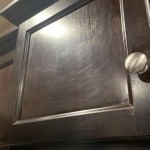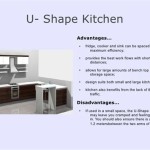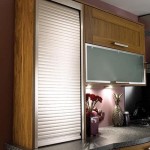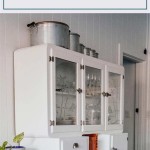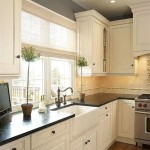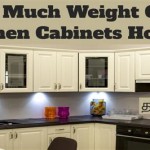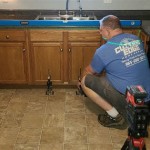Modifying Old Kitchen Cabinets: A Comprehensive Guide
Kitchen cabinets, often a substantial investment and a focal point of the room, can significantly impact the overall aesthetic and functionality of a kitchen. Over time, however, cabinets may appear outdated, sustain damage, or simply fail to meet evolving storage needs. Replacing an entire kitchen cabinetry system represents a significant expense and disruption. Therefore, modifying existing cabinets presents a cost-effective and environmentally conscious alternative. This article provides a comprehensive exploration of various methods for modifying old kitchen cabinets, encompassing techniques, considerations, and potential challenges.
The decision to modify rather than replace cabinets often hinges on several factors. The structural integrity of the existing cabinets is paramount. If the boxes themselves are sound, modification becomes a viable option. Budget constraints frequently play a crucial role, as modifications generally incur lower costs compared to full replacement. Furthermore, individuals may choose to modify cabinets to maintain a specific style or retain sentimental value associated with the original design. Finally, reducing waste through reuse aligns with sustainable practices.
Before embarking on any modification project, a thorough assessment of the existing cabinets is crucial. This involves identifying any structural weaknesses, evaluating the condition of the doors and hardware, and measuring the dimensions of the cabinets. This assessment informs the scope of the project and helps determine the necessary materials and tools.
Key Point 1: Refacing Cabinet Doors and Drawer Fronts
Refacing represents a popular modification strategy, primarily addressing the aesthetic appearance of the cabinets. It involves replacing the existing doors and drawer fronts while retaining the original cabinet boxes. This approach offers a significant visual impact without requiring extensive demolition or reconstruction. Refacing provides an opportunity to introduce a new style, color, or material to the kitchen, aligning with current design trends or personal preferences.
Several options exist for refacing materials. Wood veneer offers a classic and durable choice, providing a realistic wood grain appearance. Laminate presents a cost-effective alternative, available in a wide range of colors and patterns. Thermofoil, a vinyl material heat-bonded to a fiberboard core, offers moisture resistance and ease of cleaning. The selection of refacing material depends on budget, desired aesthetics, and performance requirements.
The refacing process typically involves removing the existing doors and drawer fronts, preparing the cabinet boxes by sanding and cleaning, and applying a veneer or laminate to the exposed surfaces. New hinges and hardware are then installed, followed by the installation of the new doors and drawer fronts. Precise measurement and careful installation are essential to ensure a seamless and professional finish.
Considerations for refacing include the condition of the cabinet boxes. If the boxes exhibit significant damage or warping, refacing may not be a suitable solution. The cost of refacing can vary depending on the size of the kitchen, the type of material chosen, and whether the work is performed by a professional or done DIY. Additionally, selecting complementary hardware, such as knobs and pulls, is crucial to achieving a cohesive and visually appealing result.
Key Point 2: Modifying Cabinet Interiors for Improved Functionality
Beyond aesthetic enhancements, modifying cabinet interiors can significantly improve the functionality and usability of the kitchen. Many older cabinets lack modern storage solutions, such as pull-out shelves, drawer organizers, and specialized storage for pots, pans, and utensils. Addressing these shortcomings can optimize space utilization and enhance cooking efficiency.
Installing pull-out shelves is a common modification that greatly improves access to items stored in lower cabinets. These shelves slide out, allowing users to easily reach items at the back without having to bend down and rummage through the entire cabinet. Pull-out shelves can be customized to fit specific cabinet dimensions and storage needs.
Drawer organizers, such as dividers and utensil trays, help to maximize space and prevent clutter within drawers. These organizers can be purchased pre-made or custom-built to accommodate specific items. They offer a more organized and efficient storage solution compared to simply placing items loosely within drawers.
Specialized storage solutions, such as pot and pan organizers, spice racks, and knife blocks, can further enhance the functionality of kitchen cabinets. These organizers provide dedicated storage for specific items, keeping them readily accessible and preventing damage. They can be installed in cabinets, on doors, or on countertops, depending on the available space and design preferences.
When modifying cabinet interiors, it is essential to consider the weight capacity of the shelves and drawers. Reinforcing existing shelves or drawers may be necessary to prevent sagging or breakage. Careful planning and precise measurement are crucial to ensure that the new storage solutions fit properly and function smoothly.
Key Point 3: Painting and Other Finish Transformations
A fresh coat of paint can dramatically transform the appearance of old kitchen cabinets. Painting offers a cost-effective way to update the color scheme and revitalize the overall look of the kitchen. The process requires meticulous preparation and careful application to achieve a professional and durable finish.
Preparation is paramount when painting cabinets. This involves removing the doors and hardware, thoroughly cleaning the surfaces to remove grease and grime, sanding to create a smooth surface, and applying a primer to promote adhesion. Skipping any of these steps can result in a poor finish that is prone to chipping and peeling.
The choice of paint is also crucial. Oil-based paints offer excellent durability but require longer drying times and can be more difficult to clean up. Latex-based paints are easier to work with, dry quickly, and are available in a wide range of colors. Cabinet-specific paints, formulated to withstand the rigors of kitchen use, are often the best choice.
Applying the paint requires patience and attention to detail. Multiple thin coats are preferable to a single thick coat, as they result in a smoother and more even finish. Using a high-quality brush or sprayer can also improve the outcome. Allowing ample drying time between coats is essential to prevent runs and drips.
Beyond painting, other finishing techniques can be employed to transform the appearance of cabinets. Staining can enhance the natural wood grain and add warmth to the kitchen. Glazing can create an antique or distressed look. These techniques require specialized skills and materials but can yield stunning results.
When undertaking any finishing project, it is crucial to work in a well-ventilated area and wear appropriate safety gear, such as a respirator and gloves. Careful planning and execution are essential to achieving a professional and long-lasting finish.
Repurposing existing cabinets by moving them to different locations within the kitchen or even to other rooms in the house represent another avenue for modification. For example, upper cabinets can be transformed into open shelving by removing the doors. Base cabinets can be repurposed as islands or storage units in other areas of the home. This approach not only saves money but also promotes sustainability by reusing existing materials.
Adding decorative elements, such as molding, trim, and panels, can enhance the visual appeal of old cabinets. These elements can be used to create a more traditional or contemporary look, depending on the style and design preferences. Molding can be added to the top of cabinets to create a more finished appearance, while decorative panels can be installed on the sides or doors to add texture and visual interest. The selection of decorative elements should complement the overall style of the kitchen and the existing cabinetry.
Lighting plays a significant role in the overall ambiance and functionality of a kitchen. Adding under-cabinet lighting can improve visibility on countertops and create a more inviting atmosphere. Interior cabinet lighting can also enhance functionality by making it easier to find items stored within the cabinets. Various lighting options are available, including LED strip lights, puck lights, and recessed lights. The choice of lighting should be based on the specific needs and design preferences.
Hardware upgrades can significantly impact the aesthetic appeal of old cabinets. Replacing outdated knobs and pulls with new hardware can instantly modernize the look of the kitchen. The selection of hardware should complement the style of the cabinets and the overall design of the kitchen. Various hardware options are available, including knobs, pulls, handles, and hinges, in a wide range of materials and finishes.
Modifying old kitchen cabinets is a versatile and cost-effective way to improve the functionality and appearance of the kitchen. By carefully assessing the existing cabinets, planning the modifications, and executing the work with precision and attention to detail, homeowners can achieve stunning results that transform their kitchens without incurring the expense and disruption of a full replacement. The techniques outlined in this article provide a comprehensive guide to modifying old kitchen cabinets, empowering individuals to create a kitchen that meets their specific needs and preferences.
How To Update Your Kitchen Cabinets Without Replacing Them Real Estate U S News

25 Easy Ways To Update Kitchen Cabinets

10 Simple Ideas To Update Your Kitchen Cabinets Jenna Sue Design

10 Simple Ideas To Update Your Kitchen Cabinets Jenna Sue Design

15 Diy Kitchen Cabinet Makeovers Before After Photos Of Cabinets

How To Update Kitchen Cabinet Doors On A Dime My Blessed Life

9 Ways To Upgrade Repair Reconfigure Your Kitchen Cabinets Feelswarm

10 Simple Ideas To Update Your Kitchen Cabinets Jenna Sue Design

Kitchen Modification At Rs 300 Square Feet In Chennai Id 13056541812

25 Easy Ways To Update Kitchen Cabinets
Related Posts

